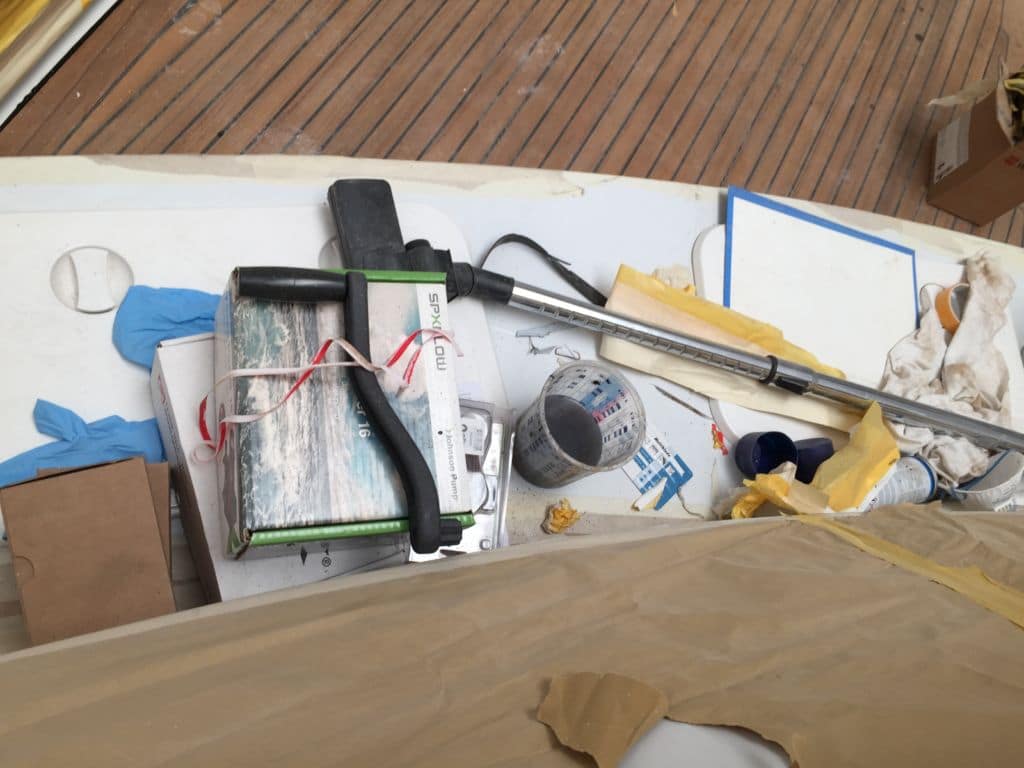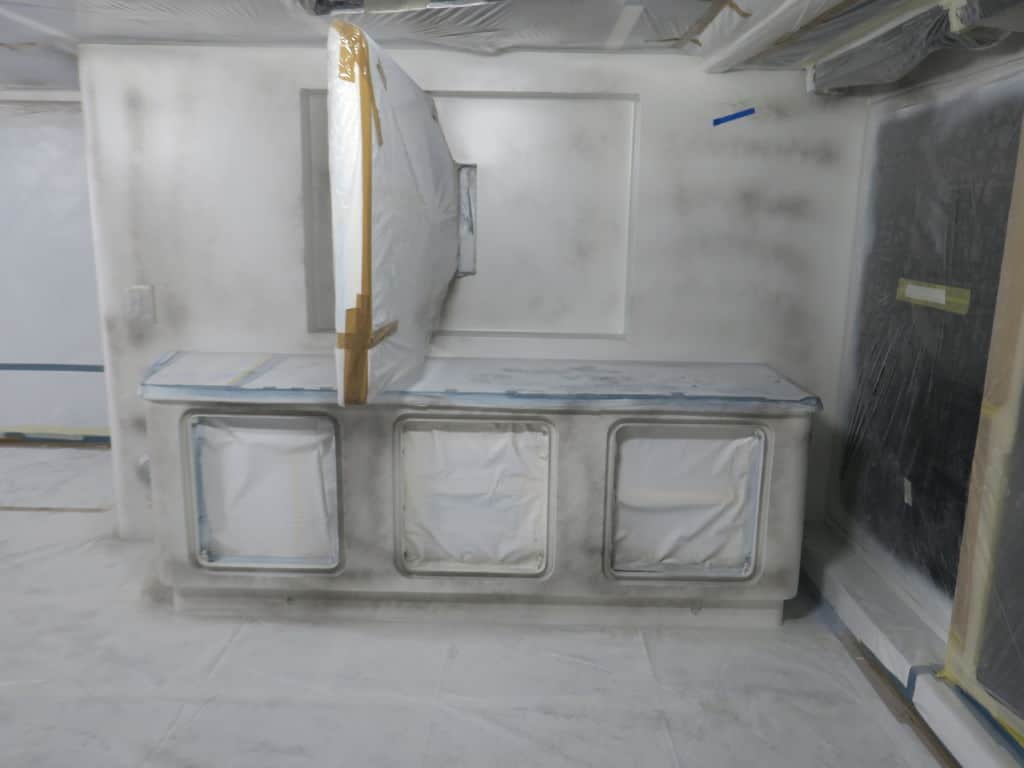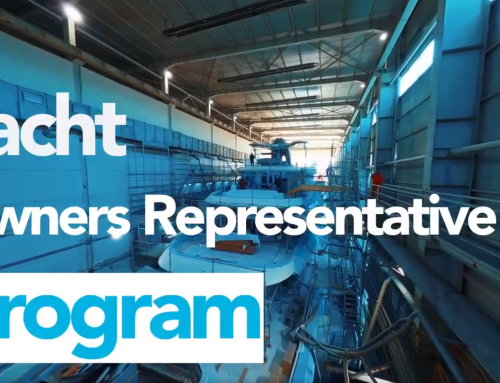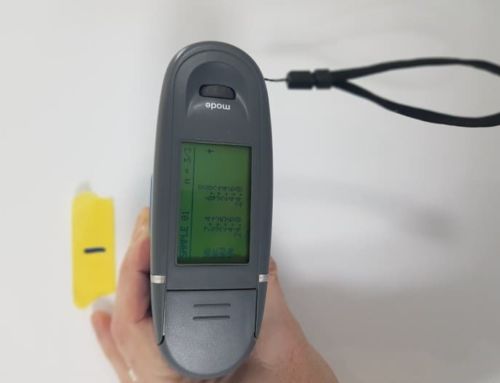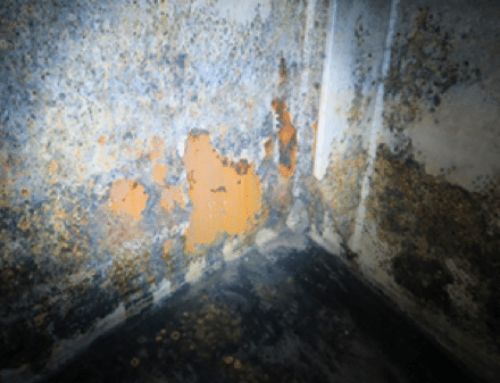Cleanliness is next to Godliness
A pristine superyacht in the marina, with shining paintwork, sparkling stainless steel elements, gleaming brightwork and flawless teak decks is not the result of luck. Paintwork in particular involves a complex process that is tough to get right and requires a perfectly well-ordered and clean environment.
Of course, for something to be beautiful and clean, it must first be built. With yachts, this is a process that involves many months and millions of man-hours. Painting alone can take hundreds of thousands of hours on thousands of square metres. Every stage of the process, from metal preparation to applying primer and top coating, requires rigorous control of the environment and perfect cleanliness. The desired appearance criteria must be achieved and maintained in the aggressive conditions in which the yacht will be used.
This means that the entire painting process must be clean and tidy, both for technical reasons and to ensure the highest level of professionalism. ‘I’m too busy to tidy up’, ‘I’m not paid to clean’ or ‘that’s someone else’s mess’ are all too common excuses heard in some projects. Just as common but more shocking, a segment may be rejected due to excessive dust in the paint or damage, which can lead to delays of a week or more. In the worst possible case, there might even be an accident.
Quality control
A tidy environment isn’t just professional: there is a direct relationship between cleanliness and quality. The cost of any additional work, like a respray made necessary by too much dust or damage caused after completion, can be huge. This applies in terms of both finances and, possibly even more damagingly, time, which is always in short supply the closer a project approaches its delivery date.
Poor tidiness and cleanliness also relate directly to safety. The cost of accidents in lost time, or worse, to people or production can be very significant. Long-term exposure to fumes and dust can be hazardous to health and cause long-term problems and absenteeism costs. Such immediate issues are bad enough, but there are also less immediate risks to the yacht, like corrosion or adhesion problems caused later during use.
New approaches
Japan may not be renowned for its superyacht building industry, but it has been at the forefront of rethinking manufacturing in the last 60 years for the purpose of maximising efficiency and productivity. It introduced new methodologies to help management and workers improve production, workplace cleanliness being a fundamental component. One of the most influential concepts devised in this context was the so-called 5S workplace organisation model, which can offer clear added value when adapted to the superyacht painting sector.
Sort
Ensure that only things needed in an area are present, with objects that are not needed stored away and redundant tools or excess material disposed of. This saves time, frees up space and increases safety.
Set in order
Fix locations for equipment and consumables. Don’t waste time looking for items. As with above, this saves time, frees up space and adds to safety.
Shine
keep everything clean every day, not just at the end of the week, ensuring that the working area is clean at all times. Broken or dangerous equipment or scaffolding should be noticed and repaired before it leads to wasted time or accidents.
Standardise
establish procedures and schedules to consistently ensure the above three principles: sort-set in order-shine.
Sustain
the translation of the original Japanese is ‘do without being told’. This means that the above principles should become routine, and the whole staff should be proactive when it comes to improvements.
Four key aspects of keeping a superyacht workplace tidy
Environment
The yard should ensure a suitable facility with adequate lighting and air extraction/ventilation at all times. Filler fumes and dust are hazardous so ventilation is of major importance during spraying, as well as during filler stages (application and sanding).
The yard should supply enough storage locations at the right places. It’s unwise to store hundreds of litres of paint under a boat (this leads to risk of fire or obstruction) and, likewise, it’s not helpful to keep paint stored a 15-minute walk away at the other end of the facility.
Process
Project management should keep all processes separate as much as possible. A common mistake to be avoided is to start painting while major metalwork (welding and grinding) is still ongoing. While this might seem to result in time savings, in practice painters may ultimately have to reject complete areas of filler due to embedded swarf. Another issue is the fact that welding fumes are hazardous to human health, and flying swarf is dangerous to eyes and hands.
Coordinating work such as teak decking and glass fitting is also of the utmost importance. All workers must stay in frequent contact to ensure that planning stays on track and there are no time conflicts. This needs to include careful thought and appreciation of all the issues and potential snag points. It’s hugely helpful to have an experienced project leader with a good relationship with the foreman/project manager for each activity. It’s easy to focus too much on fancy plans and charts, but everyone knows that there will be hiccoughs and mistakes. The key is to allow a little space for these snags and be honest in not promising unrealistic targets.
Tools
Simple solutions such as vacuum-sanding not only reduce dust in the environment, allowing prolonged use of sandpaper and more efficient and effective sanding – they are a health and safety requirement too. All types of dust are dangerous to a degree and dust from epoxy filler and primers are proven health hazards. The use of vacuums should therefore be optimised by ensuring sufficient vacuum capacity and connections for all possible situations. The number of connections needed is probably n+1: it is better to plan for too many than come up short in a week when all the painters, teak deckers and other workers suddenly need to use the system.
People
This is probably the most critical and important link. “I’m too busy to tidy” is an unacceptable attitude akin to saying “I’m too busy to work”. Everyone working on a project must be aware of the importance for quality of keeping a clean working space at all times. Project management must provide everything possible to aid in this goal. It is frustrating and not credible for employees to be told to keep tidy if the yard containers are never emptied or the toilets are always short of towels or paper.
It is an unfortunate fact that, in a boatbuilding situation, painting is dusty (sanding), noisy (sanding) and smelly (fumes). Moreover, painters are often subcontractors and frequently perceived as the lowest priority in many yards, where they get the most blame and least assistance. It’s not uncommon for other workers to complain about the noise, dust or smell associated with painting while disregarding the fact that teak deckers produce hazardous topcoat dust or welders create hazardous fumes and swarf that painters end up picking out of their hands weeks later.
This is a cultural issue and the only solution is constant reinforcement of the idea that boatbuilding is a team process and a win/win situation. Any ‘them and us’ feeling is contrary to the goals of maximising quality and minimising cost, and quickly becomes a lose/lose proposition.
Simple practical steps for yards
-
- Finish all hot work in and around an area before beginning painting. If necessary, carefully segregate and protect the separate areas. Flimsy plastic sheet won’t stop welding spatters or flying swarf produced by heavy grinding.
- Avoid walking over work in progress. Provide enough access ways, such as bridges over bulwarks to and from decks. If left to their own devices, people are very efficient, sometimes to the detriment of the common good. They will almost always take the quickest, easiest route – but damaging filler or paint isn’t worth the time saving.
- Provide enough connections for all the air, light and vacuums required so there aren’t hundreds of metres of hoses and cables entangled over the scaffolding. Sufficient connections for all activities also help eliminate things like dragging hoses over the work in progress.
- Don’t let dust build up. Constant cleaning reduces the risk of future contamination and health risks.
- Spraying creates waste in the form of overspray and fumes by definition. Define enough locations for clean air supply and extraction. The extracted air must go somewhere. Ensure there are enough venting points to the outside (while being aware and compliant with any local regulations). Don’t cover the captain’s and crew’s cars with overspray!
- At all times, but especially from final priming to final topcoat stages, all workers must be very careful to avoid any contact with the surfaces. Hoses and equipment dragged over prepared surfaces can cause contamination and/or damage that may only become visible after the topcoat is applied.
- Carry out teak sanding as late as possible. The resulting oily dust is a major source of paint issues in topcoat phases.
- Avoid stainless-steel polishing in combination with paintwork as this generates clouds of oily fibres. A typical solution is using a small tent for protection, but unless it has its own air-handling system this only localises the problem. Every time an operator walks in and out of the tent they let a cloud of potentially damaging fibres escape.
- Try to keep antifouling for last in the build process. Any antifouling dust that hangs around in the painting environment can create problems for the topcoat.
- Once painting is complete, minimise access to the relevant areas. Protect them with appropriate coverings, whether paper and/or plastic or temporary films. There is also a school of thought that no protection means less risk – out of sight can be out of mind.
- Dropping scaffold poles or drilling holes will go through most protections!
- Take care to allow new paint to fully cure before masking. Try to minimise all tape contact. Use paper to allow breathing between the paint and the protective plastic. Be careful to avoid water getting trapped between the two layers as condensation vapour can cause dull areas or blisters. Use low-tack tapes. If the boat is exposed to the environment, use only exterior-approved tapes resistant to sunlight. Leave standard tape in the sun and the glue will bond to the paint, wood and stainless steel within 24 hours and need to be removed with solvent.
- If you do get stains on fresh paint, be very careful with any solvent cleaners. Solvents can soften the paint and, in combination with rough rags, lead to permanent scratches on the surface, especially visible on dark colours.
- Take care when masking and removing masking. Paper can cut. The edges of cardboard and even paper on a roll can scratch fresh paint. If you cut your finger, remember to remove the blood from the paint.
- When preparing to apply the topcoat, clean before building tenting and finalise cleaning in the completed tent. Try to have the air-handling system running as soon as the tent is sealed. This will remove dirty air, leaving only clean air in the tent. Once you start cleaning, use best-cleaning practices. Balance the air extraction so the tent has enough air flow and the right amount of pressure. Over-pressure can make the tent expand while under-pressure will suck dirty air in.
- Make sure tents don’t simply have one entry door: build airlock corridors between the open area and the spray tent. Make sure the entry door is near the extraction point.
- Best practice just before application is to cover the area to be painted and coat the inside of tent with tack coating or paint. This aids the removal of remaining dust by making it stick to the floor or the tent. Next, remove the temporary covering and tack-rag the area before application.
- This may seem obvious but is often disregarded: the mixing of paint should occur in fresh containers for every coat. In case of a large spray session, hours may pass between coats and paint will dry on the side of the containers. If you use the same container from beginning to end of the process, you may end up introducing flakes of semi-dried paint. And you shouldn’t use any old piece of wood for the mixing. All suppliers provide metal mixing sticks, which are easy to keep clean and re-use without the risk of small pieces of wood introduced to the paint.
- If you are making a large mix batch, for instance for primers on underwater areas, be careful of using plastic buckets with heavy-duty mixers. These mixers can often gouge the plastic sides, introducing loose pieces of plastic into the mix. It is a hassle if these plastic bits then block your airless tips.
We wish you a productive, safe, healthy and clean workplace!
Written by Colin Mason, Technical Manager CCS
Would you like to learn more? Go to www.ccsyacht.com or call the CCS office on +31 7512150
 Stay up-to-date with our articles and like our
Stay up-to-date with our articles and like our
Linked In Page https://www.linkedin.com/in/ccsyacht/

